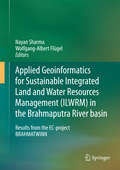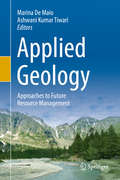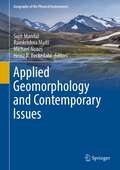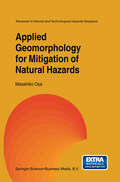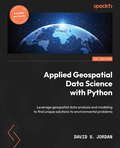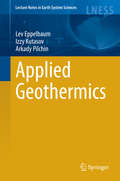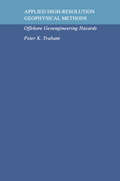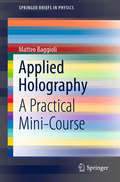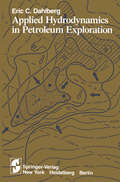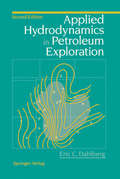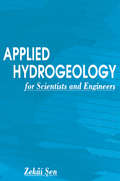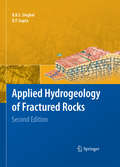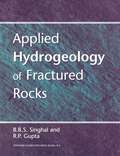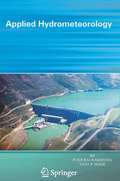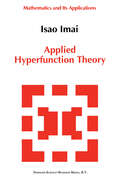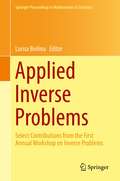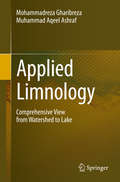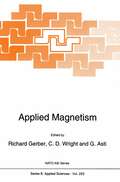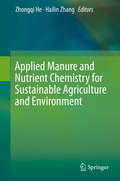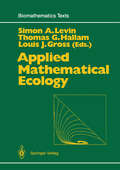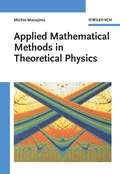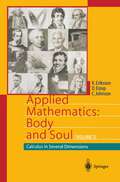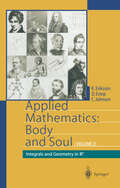- Table View
- List View
Applied Geoinformatics for Sustainable Integrated Land and Water Resources Management (ILWRM) in the Brahmaputra River basin: Results from the EC-project BRAHMATWINN
by Nayan Sharma Wolfgang-Albert FlügelThe central theme of this book is focused on the analyses and the results which emerged from the international research project BRAHMATWINN sponsored by European Commission (EC) and conducted during 2006 – 2009. The book highlights the achievements of BRAHMATWINN to carry out a harmonised integrated water resources management (IWRM) approach as addressed by the European Water Initiative (EWI) in headwater river systems of alpine mountain massifs. The latter are already impacted from climate change, and the BRAHMATWINN project established transfer of professional IWRM expertise, approaches and tools based on case studies carried out in twinning European and Asian river basins. The project addresses all important IWRM issues in a balanced way, including conflict resolution in the trans- boundary Danube and Brahmaputra River Basins in Europe and South Asia respectively.This book will be useful to researchers, professionals, managers and decision makers associated with study and application of sustainable integrated land and water resources management (ILWRM) in the backdrop of climate change.
Applied Geology: Approaches to Future Resource Management
by Marina De Maio Ashwani Kumar TiwariThis book includes a careful selection of significant contributions from international experts that were presented at the 6th AIGA Conference “Applied Geology: Approaches to Future Resource Management” that was held in the Courmayeur, Aosta Valley, Italy, from 27 - 29 June 2018. The following 7 areas are the main themes covered in this volume: · Applied Geology · Hydrogeology · Geological Exploration (underground) · Slope Instability, · Natural Hazards, Risk Assessment and Management, · Geo-resources and Sustainable Development · Application of Remote Sensing and Geographical Information Systems (GIS) The authors, from academia, research and industry present the latest state of the practice, new technologies, innovative methods and sustainable management in the field of Applied and Environmental Geology. This carefully edited work will be of value to academia, professionals, scientists and decision makers.
Applied Geomorphology and Contemporary Issues (Geography of the Physical Environment)
by Sujit Mandal Ramkrishna Maiti Michael Nones Heinz R. BeckedahlThe edited book deals with climate change and its response to river system which is one of the most burning issues of the Global environment. Due to urbanization and industrialization land degradation and resource depletion are happening and promoting livelihood challenges in the world which is reflected in the book too. The book addresses the construction of dams over large rivers and its possible consequences in the environment. Changes of the hydrology and sedimentology are to be addressed in the book. The climate change phenomena and associated geomorphic hazards and contemporary environmental issues such as sea level rise, coastal flood, drought, wind erosion, flood, soil erosion, landslide, depletion of ground water, coastal erosion etc. are elaborated in the book with suitable methods and techniques. So this edited book will contribute a lot to general to particular filed of studies and will help to geographers, geomorphologists, environmentalists, planners, policy makers and developers for studies and promoting regional plans and development.
Applied Geomorphology for Mitigation of Natural Hazards (Advances in Natural and Technological Hazards Research #15)
by M. OyaThere are many natural hazards such as floods, landslides, volcanoes and earthquakes in the Asia-Pacific Region. Nevertheless, there are few studies of such natural hazards in this region and knowledge about their mitigation is of the utmost importance. This book documents the use of geomorphological maps showing the state of flooding; these maps allow predictions to be made. The author has compiled geomorphological maps and documentation of their validation, and the maps allow not only estimation of flooding, but also prediction of soil liquefaction caused by earthquakes. Audience: The results of the discussions in this book apply not only to geographers, consultants, engineers and policy makers in Japan and Southeast Asian countries, but also to those from Europe, North America, and Africa.
Applied Geospatial Data Science With Python: Take Control Of Implementing, Analyzing, And Visualizing Geospatial And Spatial Data With Geopandas And More
by David S. JordanLeverage geospatial data analysis and modeling to find unique solutions to environmental problems
Applied Geothermics (Lecture Notes in Earth System Sciences)
by Lev Eppelbaum Izzy Kutasov Arkady PilchinThis book describes origin and characteristics of the Earth’s thermal field, thermal flow propagation and some thermal phenomena in the Earth. Description of thermal properties of rocks and methods of thermal field measurements in boreholes, underground, at near-surface conditions enables to understand the principles of temperature field acquisition and geothermal model development. Processing and interpretation of geothermal data are shown on numerous field examples from different regions of the world. The book warps, for instance, such fields as analysis of thermal regime of the Earth’s crust, evolution and thermodynamic conditions of the magma-ocean and early Earth atmosphere, thermal properties of permafrost, thermal waters, geysers and mud volcanoes, methods of Curie discontinuity construction, quantitative interpretation of thermal anomalies, examination of some nonlinear effects, and integration of geothermal data with other geophysical methods. This book is intended for students and researchers in the field of Earth Sciences and Environment studying thermal processes in the Earth and in the subsurface. It will be useful for specialists applying thermal field analysis in petroleum, water and ore geophysics, environmental and ecological studies, archaeological prospection and climate of the past.
Applied High-Resolution Geophysical Methods: Offshore Geoengineering Hazards
by P.K. TrabantThe discipline encompassing the use of high-resolution geophysics for obtaining geoengineering survey data has evolved rapidly over the past decades to become an interdisciplinary subject encompassing the fields of Geophysics, engineering, geology, marine geology, oceanography, and civil engineering. While high-resolution geophysical surveys are routinely performed offshore today, this has been so only since the late 1960s. High-resolution geophysical methods are employed in the offshore environment to obtain a comprehensive picture of the sea-floor mor phology and underlying shallow stratigraphy. The purpose of the survey methods is to assist in the design and installation of bottom-supported structures such as drilling and production platforms and pipelines. Drilling structures and pipelines of steel and/or concrete have become behemoths with respect to their size and the complexity of their design in order to withstand, for periods of up to twenty-five years, an extremely harsh environment, including storm waves, strong currents, unstable sea floor conditions, and great water depths. It is therefore of paramount importance that the geometry and physical properties of the sea floor be well understood in order to provide an adequate foundation for the design lives of such structures. On land, engineering foundation data usually may be obtained by visual field inspection and shallow borehole information, but offshore the presence of the water column places certain constraints on geoengineering investigations. High-resolution geophysical methods employed in the acquisition of geoengineering data offshore are defined as the use of seismic sources and receivers that operate at acoustic frequencies greater than 100 Hz.
Applied Holography: A Practical Mini-Course (SpringerBriefs in Physics)
by Matteo BaggioliThis primer is a collection of notes based on lectures that were originally given at IIT Madras (India) and at IFT Madrid (Spain). It is a concise and pragmatic course on applied holography focusing on the basic analytic and numerical techniques involved. The presented lectures are not intended to provide all the fundamental theoretical background, which can be found in the available literature, but they concentrate on concrete applications of AdS/CFT to hydrodynamics, quantum chromodynamics and condensed matter. The idea is to accompany the reader step by step through the various benchmark examples with a classmate attitude, providing details for the computations and open-source numerical codes in Mathematica, and sharing simple tricks and warnings collected during the author’s research experience. At the end of this path, the reader will be in possess of all the fundamental skills and tools to learn by him/herself more advanced techniques and to produce independent and novel research in the field.
Applied Hydrodynamics in Petroleum Exploration
by E. C. DahlbergIt has for some time been the author's opinion that the need exists for a complete, self-contained volume on hydrodynamics addressed to and written in an idiom for geologists and geophysicists actively engaged in the search for hydrocarbons. This book is offered as my attempt to satisfy this need. Explorationists traditionally concern themselves with four basic aspects of oil and gas occurrence, since these constitute the necessary con ditions enhancing the likelihood of subsurface hydrocarbon accumula tions. They are: Trap, Reservoir, Source, and the Fluids themselves. His torically, great attention has been paid to traps and reservoirs, and much pertinent literature on structure, stratigraphy and lithology is available. With respect to sources, an increasing body of literature is becoming avail able in the form of articles, books and research reports in the areas of geochemistry and mineralogy. It is to the largely ignored fourth aspect, the fluids, that this book is directed. In its formulation I have drawn from numerous sources: college physics texts ("hydrodynamics is one of the most difficult subjects in physics"), personal notes from a rigorous two-week course presented by M. K. Hub bert (who literally fathered the discipline), journal articles (some strong and others weak in their treatment of the subject), discussions with expe rienced exploration geologists (some of whom have successfully utilized these procedures and others who were not so sure), and experience gained as well as mistakes made in the course of my own personal oil and gas exploration activities.
Applied Hydrodynamics in Petroleum Exploration
by Eric C. DahlbergIn the first edition of this book, we observed that it had been created to fill a need for a usable "self-contained volume on hydrodynamics" (and hydrogeology) that was written specifically for the petroleum industry, but could also serve the earth science community in general. When the first edition was published (1982), M. K. Hubbert, the father of petroleum hydrodynamics, was approaching the final stages of his very productive career. For this reason, the book served as a vehicle to amplify his concepts and spread and stimulate applications of some of his theories and methods throughout the exploration sectors of the petroleum industry. This was accomplished by blending discussions of Hubbert's concepts with some of the procedures used by industry specialists to answer practical oil and gas questions. The simple aim of the book was to bring this material to the fingertips of working geologists and geophysicists, who were "evaluating the hydrocarbon possibilities in larger exploration regions or assessing the potential of small, local subsurface oil and gas prospects. " It was also hoped that by treating areas of conceptual overlap between petroleum geology and ground water hydrology, workers in both disciplines would be brought into closer contact, resulting in mutual benefits gained through healthy scientific and technical interaction. This remains our objective in the second edition, although it has become apparent that additional material is needed to satisfactorily achieve it. The size of this volume reflects the new subject matter.
Applied Hydrogeology for Scientists and Engineers
by Zekai SenIn order to properly plan, design, and operate groundwater resources projects, it is necessary to measure - over time or distance - pertinent groundwater variables such as drawdown and discharge in the field. Applied Hydrogeology for Scientists and Engineers shows how to assess and interpret these data by subsurface geological setup and processing. The book helps readers estimate relevant groundwater parameters such as storativity, transmissivity, and leakage coefficient.The text addresses many interrelated disciplines such as geology, hydrology, hydrogeology, engineering, petroleum geology, and water engineering. Traditional and current models for application are presented. One of the unique features of the book is the inclusion of new and previously unpublished ideas, concepts, techniques, approaches, and procedures developed by the author. Among these are hydrogeophysical concepts, slope matching techniques, volumetric approach solution for complicated groundwater flows, non-Darcian flow law applications, aquifer sample functions, dimensionless-type straight line methods, non-linear flow-type curves, discharge calculations from early time-drawdown data, storage coefficient estimation procedure for quasi-steady state flow, and much more. The pitfalls in aquifer test analysis are also detailed. Fractured medium flow adds yet another dimension to the book. Each method is supplemented by actual field data applications from worldwide case studies.Applied Hydrogeology for Scientists and Engineers covers the topics of groundwater reservoirs, the evaluation of aquifer parameters, aquifer and flow properties, flow properties and bore hole tests, aquifer tests in porous and fractured media, well hydraulics, groundwater flow and aquifer tests, and field measurements and their interpretations.This new reference also works well as a post-graduate textbook on the subject. Applied Hydrogeology for Scientists and Engineers expands the reader's knowledge by providing valuable information not found in any other publication.
Applied Hydrogeology for Scientists and Engineers
by Zekai SenIn order to properly plan, design, and operate groundwater resources projects, it is necessary to measure - over time or distance - pertinent groundwater variables such as drawdown and discharge in the field. Applied Hydrogeology for Scientists and Engineers shows how to assess and interpret these data by subsurface geological setup and processing. The book helps readers estimate relevant groundwater parameters such as storativity, transmissivity, and leakage coefficient.The text addresses many interrelated disciplines such as geology, hydrology, hydrogeology, engineering, petroleum geology, and water engineering. Traditional and current models for application are presented. One of the unique features of the book is the inclusion of new and previously unpublished ideas, concepts, techniques, approaches, and procedures developed by the author. Among these are hydrogeophysical concepts, slope matching techniques, volumetric approach solution for complicated groundwater flows, non-Darcian flow law applications, aquifer sample functions, dimensionless-type straight line methods, non-linear flow-type curves, discharge calculations from early time-drawdown data, storage coefficient estimation procedure for quasi-steady state flow, and much more. The pitfalls in aquifer test analysis are also detailed. Fractured medium flow adds yet another dimension to the book. Each method is supplemented by actual field data applications from worldwide case studies.Applied Hydrogeology for Scientists and Engineers covers the topics of groundwater reservoirs, the evaluation of aquifer parameters, aquifer and flow properties, flow properties and bore hole tests, aquifer tests in porous and fractured media, well hydraulics, groundwater flow and aquifer tests, and field measurements and their interpretations.This new reference also works well as a post-graduate textbook on the subject. Applied Hydrogeology for Scientists and Engineers expands the reader's knowledge by providing valuable information not found in any other publication.
Applied Hydrogeology of Fractured Rocks: Second Edition
by B.B.S. Singhal † R.P. GuptaHydrogeology is a topical and growing subject as the earth's water resources become scarcer and more vulnerable. More than half of the surface area of continents is covered with hard rocks of low permiability. This book deals comprehensively with the fundamental principles for understanding the hydrogeological characteristics of rocks, as well as exploration techniques and assessment. It also provides in depth discussion on structural mapping, remote sensing, geophysical exploration, GIS, groundwater flow modelling and contaminant transport, field hydraulic testing including tracer tests, groundwater quality, geothermal reservoirs, managed aquifer recharge, and resources assessment and management. Hydrogeological aspects of various lithology groups, including crystalline rocks, volcanic rocks, carbonate rocks and clastic formations have been dealt with separately, using and discussing examples from all over the world. It will be an invaluable text book cum reference source for postgraduate students, researchers, exploration scientists and engineers engaged in the field of groundwater development in fractured rocks. Applied Hydrogeology of Fractured Rocks - Second Edition is thoroughly revised and extended with a new chapter, updated sections, many new examples, and expanded and updated references.
Applied Hydrogeology of Fractured Rocks
by B.B.S. Singhal † R.P. GuptaHydrology is a topical and growing subject, as the earth's water resources become scarcer and more vulnerable. Although more than half the surface area of continents is covered with hard fractured rocks, there has until now been no single book available dealing specifically with fractured rock hydrogeology. This book deals comprehensively with the fundamental principles for understanding these rocks, as well as with exploration techniques and assessment. It also provides in-depth discussion of structural mapping, remote sensing, geophysical exploration, GIS, field hydraulic testing, groundwater quality and contamination, geothermal reservoirs, and resources assessment and management. Hydrogeological aspects of various lithology groups, including crystalline rocks, volcanic rocks, carbonate rocks and clastic formations, are dealt with separately, using and discussing examples from all over the world. Applied Hydrogeology of Fractured Rocks will be an invaluable reference source for postgraduate students, researchers, exploration scientists, and engineers engaged in the field of groundwater development in fractured rock areas.
Applied Hydrogeophysics (Nato Science Series: IV: #71)
by Harry Vereecken Andrew Binley Giorgio Cassiani André Revil Konstantin TitovThis book focuses on the the application of hydrogeophysical methods to the understanding of hydrological processes and environmental problems dealing with the flow of water and the transport of solutes and contaminants. Taking a process-driven approach, the book offers a series of process-driven chapters, each authored by leading experts. Areas covered include: infiltration and solute transport processes, biogeochemical functioning of soil-water systems, coastal groundwater interactions, cold region hydrology, engineered barriers and landfill processes.
Applied Hydrometeorology
by Pukhraj Rakhecha Vijay P. SinghWater is vital for life. Since the dawn of civilization, much effort has been made to harness sources of fresh water. Recent years have raised global awareness of the need for increasing demand of water worldwide, largely because of growing population, rising standard of living, higher demand for energy, and greater appreciation for environmental quality. As an example, the world population has increased threefold in the past five decades. In order to meet the rising water demand, water resources are being developed by building large dams, reservoirs, barrages and weirs across rivers worldwide. The guiding principle for water resources development has been to ensure adequate supply of water for agriculture, domestic use (including fine drinking water), waste disposal, industries, and energy production, with due attention to maintain the ecosystem functions. This development, however, depends on a holistic, cooperative and scientific approach. The basic inputs in the assessment of water resources for a given region are from hydrological data and the subject of hydrology forms the core in achieving sustainable development of water resources. Barring a few exceptions, hydrological data for most river basins are sparse and therefore it is difficult to comprehensively assess their water resources. The major source of water is rainfall which occurs as a result of condensation of atmospheric moisture governed by the science of meteorology.
Applied Hyperfunction Theory (Mathematics and its Applications #8)
by Isao ImaiGeneralized functions are now widely recognized as important mathematical tools for engineers and physicists. But they are considered to be inaccessible for non-specialists. To remedy this situation, this book gives an intelligible exposition of generalized functions based on Sato's hyperfunction, which is essentially the `boundary value of analytic functions'. An intuitive image -- hyperfunction = vortex layer -- is adopted, and only an elementary knowledge of complex function theory is assumed. The treatment is entirely self-contained. The first part of the book gives a detailed account of fundamental operations such as the four arithmetical operations applicable to hyperfunctions, namely differentiation, integration, and convolution, as well as Fourier transform. Fourier series are seen to be nothing but periodic hyperfunctions. In the second part, based on the general theory, the Hilbert transform and Poisson-Schwarz integral formula are treated and their application to integral equations is studied. A great number of formulas obtained in the course of treatment are summarized as tables in the appendix. In particular, those concerning convolution, the Hilbert transform and Fourier transform contain much new material. For mathematicians, mathematical physicists and engineers whose work involves generalized functions.
Applied Inverse Problems: Select Contributions from the First Annual Workshop on Inverse Problems (Springer Proceedings in Mathematics & Statistics #48)
by Larisa BeilinaThis proceedings volume is based on papers presented at the First Annual Workshop on Inverse Problems which was held in June 2011 at the Department of Mathematics, Chalmers University of Technology. The purpose of the workshop was to present new analytical developments and numerical methods for solutions of inverse problems. State-of-the-art and future challenges in solving inverse problems for a broad range of applications was also discussed. The contributions in this volume are reflective of these themes and will be beneficial to researchers in this area.
Applied Limnology: Comprehensive View from Watershed to Lake
by Mohammadreza Gharibreza Muhammad Aqeel AshrafA multidisciplinary study of Bera Lake in Malaysia is presented here, focusing on natural resources throughout the lake’s catchment area and assessing environmental impact. This applied limnology study examines issues relating to land development including soil erosion and nutrient loss in the catchment area, severe pollution of water, sediment resources in open waters and wetlands, and reduction of aquatic and bird populations. The chapters provide a comprehensive view of problems, risks and possible mitigation measures associated with this great natural habitat. The book highlights the technology and methods used to estimate both soil erosion rate and nutrient loss from the lake catchment, including an explanation of the measurement of the sedimentation rate in Bera Lake using 137Cs and 210Pb radioisotopes. The author examines the current and historic situation of contamination in sediments, presents an ecological risk assessment, and finally describes a master management plan, proposing practices to mitigate the environmental impacts of existing agricultural projects and practices to control future projects. Readers will learn of a decrease in the watershed supply of water to Bera Lake, of shoaling, degradation of water and sediment quality, and the extinction of several kinds of flora and fauna. This volume also offers an approach to sustainable land use with regard to natural resources conservation.
Applied Magnetism (NATO Science Series E: #253)
by R. Gerber C. D. Wright G. AstiThis book is based on the contributions to a course, entitled Applied Magnetism, which was the 25th Course of the International School of Materials Science and Technology. The Course was held as a NATO Advanced Study Institute at the Ettore Majorana Centre in Erice, Sicily, Italy between the 1st and 12th July 1992, and attracted almost 70 participants from 15 different countries. The book deals with the theory, experiments and applications of the main topical areas of applied magnetism. These selected areas include the physics of magnetic recording, magnetic and magneto-optic recording devices, systems and media, magnetic fine particles, magnetic separation, domains and domain walls in soft magnetic materials, permanent magnets, magnetoresistance, thin film magneto-optics, and finally, microwave, optical and computational magnetics. The material is organised into I 0 self-contained chapters which together provide a comprehensive coverage of the subject of applied magnetism. The aim is to emphasise the connection between the fundamental theoretical concepts, key experiments and the important technological developments which have been achieved in this field up to the present time. Moreover, when and where possible, pointers to future trends are indicated which hopefully, together with the background material, will promote further advancement of research. The organizing committee would like to acknowledge the sponsorship of the NATO Scientific Affairs Division, the National Science Foundation of the USA, the Science and Engineering Research Council of the UK, the Italian Ministry of Education, the Italian Ministry of University and Scientific Research and the Sicilian Regional Government.
Applied Manure and Nutrient Chemistry for Sustainable Agriculture and Environment
by Zhongqi He Hailin ZhangDue to the rapid increase in world population and improving living standards, the global agriculture sector is confronting with challenges for the sustainability of agricultural production and of the environment. Intensive high-yield agriculture is typically dependent on addition of fertilizers (synthetic chemicals, animal manure, etc.). However, non-point nutrient losses from agricultural fields due to fertilization could adversely impact the environment. Increased knowledge on plant nutrient chemistry is required for improving utilization efficiency and minimizing loses from both inorganic and organic nutrient sources. For this purpose, the book is composed of 19 chapters that highlight recent research activities in applied nutrient chemistry geared toward sustainable agriculture and environment. Topics of interest include, but are not limited, to speciation, quantification, and interactions of various plant nutrients and relevant contributories in manure, soil, and plants. This book outlooks emerging researchable issues on alternative utilization and environmental monitoring of manure and other agricultural by products that may stimulate new research ideas and direction in the relevant fields.
Applied Mathematical Ecology (Biomathematics #18)
The Second Autumn Course on Mathematical Ecology was held at the Intern ational Centre for Theoretical Physics in Trieste, Italy in November and December of 1986. During the four year period that had elapsed since the First Autumn Course on Mathematical Ecology, sufficient progress had been made in applied mathemat ical ecology to merit tilting the balance maintained between theoretical aspects and applications in the 1982 Course toward applications. The course format, while similar to that of the first Autumn Course on Mathematical Ecology, consequently focused upon applications of mathematical ecology. Current areas of application are almost as diverse as the spectrum covered by ecology. The topiys of this book reflect this diversity and were chosen because of perceived interest and utility to developing countries. Topical lectures began with foundational material mostly derived from Math ematical Ecology: An Introduction (a compilation of the lectures of the 1982 course published by Springer-Verlag in this series, Volume 17) and, when possible, progressed to the frontiers of research. In addition to the course lectures, workshops were arranged for small groups to supplement and enhance the learning experience. Other perspectives were provided through presentations by course participants and speakers at the associated Research Conference. Many of the research papers are in a companion volume, Mathematical Ecology: Proceedings Trieste 1986, published by World Scientific Press in 1988. This book is structured primarily by application area. Part II provides an introduction to mathematical and statistical applications in resource management.
Applied Mathematical Methods in Theoretical Physics
by Michio MasujimaAll there is to know about functional analysis, integral equations and calculus of variations in a single volume. This advanced textbook is divided into two parts: The first on integral equations and the second on the calculus of variations. It begins with a short introduction to functional analysis, including a short review of complex analysis, before continuing a systematic discussion of different types of equations, such as Volterra integral equations, singular integral equations of Cauchy type, integral equations of the Fredholm type, with a special emphasis on Wiener-Hopf integral equations and Wiener-Hopf sum equations. After a few remarks on the historical development, the second part starts with an introduction to the calculus of variations and the relationship between integral equations and applications of the calculus of variations. It further covers applications of the calculus of variations developed in the second half of the 20th century in the fields of quantum mechanics, quantum statistical mechanics and quantum field theory. Throughout the book, the author presents over 150 problems and exercises - many from such branches of physics as quantum mechanics, quantum statistical mechanics, and quantum field theory - together with outlines of the solutions in each case. Detailed solutions are given, supplementing the materials discussed in the main text, allowing problems to be solved making direct use of the method illustrated. The original references are given for difficult problems. The result is complete coverage of the mathematical tools and techniques used by physicists and applied mathematicians Intended for senior undergraduates and first-year graduates in science and engineering, this is equally useful as a reference and self-study guide.
Applied Mathematics: Calculus in Several Dimensions
by Kenneth Eriksson Donald Estep Claes JohnsonApplied Mathematics: Body & Soul is a mathematics education reform project developed at Chalmers University of Technology and includes a series of volumes and software. The program is motivated by the computer revolution opening new possibilitites of computational mathematical modeling in mathematics, science and engineering. It consists of a synthesis of Mathematical Analysis (Soul), Numerical Computation (Body) and Application. Volumes I-III present a modern version of Calculus and Linear Algebra, including constructive/numerical techniques and applications intended for undergraduate programs in engineering and science. Further volumes present topics such as Dynamical Systems, Fluid Dynamics, Solid Mechanics and Electro-Magnetics on an advanced undergraduate/graduate level. The authors are leading researchers in Computational Mathematics who have written various successful books.
Applied Mathematics: Volume 2: Integrals and Geometry in IRn
by Kenneth Eriksson Donald Estep Claes JohnsonApplied Mathematics: Body & Soul is a mathematics education reform project developed at Chalmers University of Technology and includes a series of volumes and software. The program is motivated by the computer revolution opening new possibilities of computational mathematical modeling in mathematics, science and engineering. It consists of a synthesis of Mathematical Analysis (Soul), Numerical Computation (Body) and Application. Volumes I-III present a modern version of Calculus and Linear Algebra, including constructive/numerical techniques and applications intended for undergraduate programs in engineering and science. Further volumes present topics such as Dynamical Systems, Fluid Dynamics, Solid Mechanics and Electro-Magnetics on an advanced undergraduate/graduate level. The authors are leading researchers in Computational Mathematics who have written various successful books.
